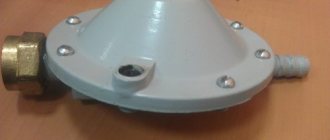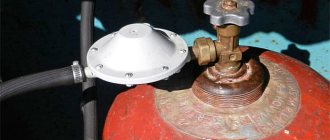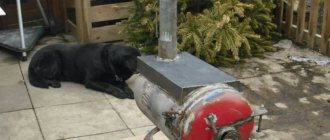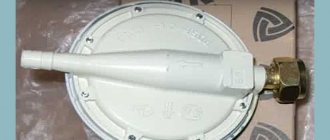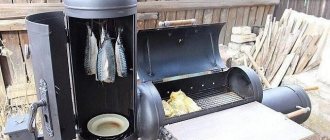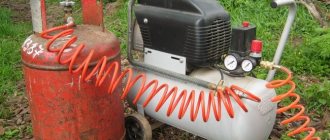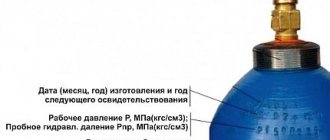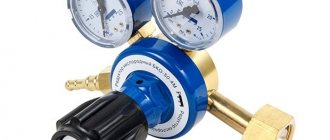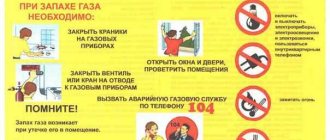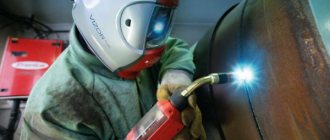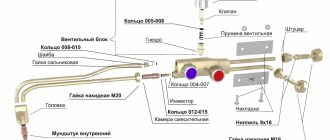Description
These propane cylinders are used for transportation and storage of liquefied hydrocarbon gases. They are made from a range of metals that are resistant to corrosion. The cylinder has the ability to withstand high pressure, but at the same time, during operation, it is necessary to prevent sudden increases in temperature, as this can lead to an increase in pressure.
Cylinders with a volume of 50 liters are equipped with valves VB-2, VK-94 (with subsequent connection to it of a pressure regulator RDSG 1-1, 2) or valve KB-2 (using a pressure regulator RDSG 2-1, 2). During work related to gas-flame processing of materials, welding in shielding gases, and plasma cutting, this propane cylinder is used.
Steel gas cylinder design
For transportation and storage of light hydrocarbons such as propane, propane-butane or butane, composite cylinders with a capacity of up to 47 liters can be used.
However, more capacious, 50 liter vessels for liquefied hydrocarbons are made of steel. To store other liquefied or compressed gases, only steel tanks of various capacities are used.
GOST 15860 describes in detail the types, characteristics and permissible sizes of gas cylinders for hydrocarbons. GOST 949-73 specifies the parameters of gas tanks suitable for operation, with internal pressure up to 19.6 MPa.
The wall thickness is dictated by GOST standards regulating the design of cylinders. The blanks for steel 50 liter cylinders are seamless pipes made of steel grades: 45, 34CrMo4, 30ХМА and 30ХГСА
Both GOSTs indicate that for safe transportation and storage of gases, each vessel must have the following structural elements:
- Support shoe.
- A body consisting of a shell, lower and upper bottom and a backing ring.
- Information plate.
- Neck.
- Valve or tap.
Modifications are allowed that include a collar, handle/handles and a cap.
In addition to the basic standards for the manufacture of gas cylinders, there are additional standards that manufacturers must comply with.
Supporting documentation includes safety rules: PB 03-576-03 “Rules for the design and safe use of pressure vessels.” They describe in detail the requirements for valves and other auxiliary mechanisms.
To avoid problems when working with a cylinder, the following safety measures must be taken into account:
- In the room where the cylinder is used and stored, the air temperature should not exceed 45 °C.
- Filled cylinders are also prohibited from being heated by sunlight or other heat sources.
- Care must be taken to ensure that cylinders are not subject to accidental drops or impacts.
It is necessary to check the gas cylinder for the possibility of gas leakage. If you smell gas in the room, you should immediately stop using the gas cylinder. Next, immediately close the valve on the cylinder and turn off the tap of the gas heater. The next step is to ventilate the room, open a window or door until the smell of gas is completely eliminated; during this time, it is forbidden to light a fire, smoke, or turn on electric lighting in the room.
A 50 liter cylinder is widely used as an excellent fuel for heating. For example, many residents of private homes use propane cylinders to heat residential and commercial buildings. This is due to a number of advantages in use, since propane is economical in price, and you can buy propane cylinders in any locality.
Gas cylinder color
Rules PB 03-576-03 state that the outer surface of vessels intended for transporting gases must be painted in the appropriate color. It depends on the type of gas that will be filled.
Red cylinders are provided for butane and other flammable gases. Moreover, for some gases not only a color is provided, but also a corresponding color stripe.
Inscriptions and stripes are applied with durable paints and if they are erased during use, then re-application occurs at filling stations or testing points. That's why gas cylinders always give away their contents.
In addition, the standards establish an identifying inscription that should be applied to the vessel. The word “Butane” must be printed on the butane cylinder, and “Propane” on the propane cylinder. The text color of the inscription on a vessel with hydrocarbon gas is white. Read more about the types of gas cylinders below.
A 50 liter propane cylinder has the following technical characteristics.
• working pressure, MPa 1.6; • test pressure, MPa 2.5; • overall dimensions: Shell diameter, mm 292; • height, mm 1015; • wall thickness, mm 3; • material: steel B Art. 3 sp. Empty cylinder weight, kg 19; • mass of liquefied gas, kg 23.
Size chart of composite (lightweight, type 3, CNG-3) gas cylinders for methane (natural gas).
| The cost of cylinders (type 3) including installation* is 550 rubles/liter according to the price list |
CNG-3 methane cylinders, the average coefficient of perfection (mass to volume ratio) = 0.65 , i.e. a 100 liter cylinder will weigh approximately 65 kg.
| Volume, l | Gas capacity, m3 | Outer diameter, mm | Length, mm | Weight, kg | Max. working pressure, MPa | Test pressure, MPa |
| 47 | 11,75 | 326 | 860 | 33,6 | 20 | 30 |
| 50 | 12,5 | 326 | 900 | 35,2 | 20 | 30 |
| 67 | 16,75 | 326 | 1140 | 44,6 | 20 | 30 |
| 80 | 20 | 326 | 1360 | 53,2 | 20 | 30 |
| 100 | 25 | 326 | 1660 | 65 | 20 | 30 |
| 123 | 30,75 | 326 | 2000 | 78,4 | 20 | 30 |
| 67 | 16,75 | 398 | 840 | 45,6 | 20 | 30 |
| 80 | 20 | 398 | 965 | 52,3 | 20 | 30 |
| 85 | 21,25 | 398 | 1015 | 55 | 20 | 30 |
| 96 | 24 | 398 | 1125 | 61,1 | 20 | 30 |
| 100 | 25 | 398 | 1165 | 63,5 | 20 | 30 |
| 132 | 33 | 398 | 1485 | 80,5 | 20 | 30 |
| 160 | 40 | 398 | 1765 | 99,5 | 20 | 30 |
| 185 | 46,25 | 398 | 2005 | 108,5 | 20 | 30 |
Read also: How current flows in a transistor
see also
What is the volume of propane in a 50 liter cylinder?
Propane gas is used to ensure the operation of cooking stoves, heating residential, industrial and warehouse premises, refueling cars, gas welding and metal cutting.
In our country, steel propane cylinders with a capacity of 5, 12, 27 and 50 liters are most often used for domestic gas supply. Such containers are easy to distinguish from others - they are always painted red.
The word "PROPANE" must be written in white capital letters approximately 6 cm high.
In order to order a propane cylinder, you just need to call us or fill out the feedback form on the website. Our consultants will be happy to provide comprehensive information on any issue related to gas equipment. Our offers are transparent and profitable, just like propane gas itself.
Propane cylinder device
Structurally, they are containers made of carbon steel 3 mm thick. A stamped bottom with a stand-shoe is welded to a single-seam welded cylinder on one side, and a hemispherical neck for installing a valve on the other.
Various filling or dispensing equipment is connected to the latter. The majority of propane consuming devices (gas stoves, titaniums, welding torches, heating boilers) require reduced pressure.
To do this, a reducer is installed on the valve (the most common is BPO-5-5).
On the upper part of the neck there is a passport on which the main technical parameters of the device are stamped. These include: name of the manufacturing plant, quality control department stamp, individual number, month and year of manufacture, inspection date (updated every 5 years), volume, weight in empty and filled state.
Weight and size of cylinders of various capacities
How many kg of propane are in 1 5, 12, 27, 50 liter cylinder? You can find this out in the product quality certificate or in the table below. Here you can also find out how much a 5, 12, 27, 50 liter propane cylinder weighs.
Volume 5 liters 12 liters 27 liters 50 liters
| Empty cylinder weight, kg | 4 | 5,5 | 14,5 | 22,0 |
| Propane tank weight, kg | 6 | 11 | 25,9 | 43,2 |
| Mass of stored gas, kg | 2 | 5,5 | 11,4 | 21,2 |
| Cylinder height, mm | 290 | 500 | 600 | 930 |
| Cylinder diameter, mm | 200 | 230 | 299 | 299 |
What is the thread on a propane tank?
Valves of the VB-2 type are installed on most household cylinders for propane-butane mixture. These shut-off devices are manufactured in accordance with GOST 21804-94 and are designed for pressures up to 1.6 MPa. The tap has a left-hand thread SP21.8-1 (6 turns), which allows you to connect any gearboxes with a union nut and a similar thread.
The valve provides a strong connection to the neck, complete tightness, has clear markings and a modern design. Threaded surfaces are lubricated with a special lubricant that reduces friction during operation.
The screw plug with rubber gasket prevents gas leakage during transportation or storage. The device provides protection against unqualified repairs by persons who have not undergone appropriate training.
The reliability of the locking device contributes to long-term and safe operation of the gas cylinder structure.
Brushes for painting on ceramics
How many m3 of propane are in 1 5, 12, 27, 50 liter cylinder?
We have made special calculations that conditionally transform propane-butane into a gaseous state. Under standard conditions (100 kPa, 288 K), 0.526 m³ of propane or 0.392 m³ of butane is formed from 1 kg of liquefied gas.
Taking into account the percentage of the mixture (60% prop.), the volume of combustible gas is calculated using the formula M*(0.526*0.6+0.392*0.4). How many cubic meters are in a propane tank can be seen in the table below.
The last line shows the number of liters of propane-butane mixture (in the liquid phase).
Cylinder capacity (l) 5 12 27 50
| Capacity (cubic meters of flammable gas) | 0,95 | 2,59 | 5,38 | 10,01 |
| Liquid propane volume (liters) | 4,3 | 10,2 | 22,9 | 42,5 |
It should be borne in mind that the calorific value of the propane-butane mixture is three times higher than that of natural gas (methane).
Rules for the safe operation of propane cylinders
- When using and storing, do not allow the cylinders to overheat (for example, leave them in direct sunlight for a long time);
- It is not recommended to bleed out the propane-butane mixture until the tank is completely empty (under certain conditions it can suck in air, and this is dangerous);
- When transporting, be sure to use plugs and safety caps;
- in case of detection of dents or other defects, the product must be sent for an unscheduled recheck;
- Individuals are allowed to transport no more than five cylinders in one vehicle (they must be separated by spacers from each other).
- It is necessary to constantly monitor the condition of the cylinders, because it is not for nothing that they are considered fire and explosive objects.
120 Comments “Size Chart of Composite Gas Cylinders (Type 3) for Methane”
Hello. Volkswagen Passat sedan 2008. How much does a cubic methane cylinder fit normally?
Hello! Please call (opening hours Mon-Fri from 8 to 20, Saturday from 10 to 17, lunch from 14 to 15, closed on Sun), specialists will advise you. You can also sign up for a fitting and choose the optimal cylinder volume; there is a large selection available.
How much will it cost to install methane with a H406.089.S3 cylinder on a Peugeot 308 hatchback?
Good afternoon, I have a 1991 Toyota Town ace petrol. I took gasoline specifically for installation under methane. The cylinder itself will be installed on the trunk roof. I want to install a composite cylinder, one long one with a large volume, at the maximum, in the middle. I'll do the mounting for the cylinder myself. Please tell me at least the approximate cost of installing methane equipment. And installation time. I will be grateful.
Hello, Leonid! Regarding the possibility of installing a cylinder on the roof of the trunk, it is better for you to consult with managers. The cost of installing gas gas equipment for methane is from 70,000 rubles, depending on the brand of equipment and the volume/type of cylinder, you can estimate it in the calculator https://elitegas.ru/gbo-price-calculator/ Please call (opening hours from 8 to 20 on Mon- Fri, from 10 to 17 on Sat, closed Sun).
Hello, I want to install methane on a Kia Karens 7 seater, under the bottom for a spare tire. Balcony length 0.60 cm. What do you advise ?
Hello Abdullah! It is not clear what you mean by balcony. We recommend calling, clarifying all the details and making an appointment to try on a cylinder. Please call (opening hours Mon-Fri from 8 to 20, Saturday from 10 to 17, lunch from 14 to 15, closed Sun)
Balcony length 0.60 cm
Don't experiment with high pressure. Life threatening. Moreover, you will not be able to register this with the traffic police. For the first time 500 rubles. On the second – deregistration of the vehicle.
what kind of roof are you talking about Leonid? There is a crazy Pressure of 200 Atmospheres.
in the body or better under the bottom in a niche or instead of a gas tank.
come, let's do everything according to our minds
Hello. I'm interested in installing a methane gas system on a '13 Camry 2.5 liter. Will 3 50 liter cylinders of the third type fit in without interfering with the spare wheel? Cost of work? Main criteria, maximum gas volume with minimal space consumption, optimal price. Thank you.
Hello Dmitry! Whether the cylinders will fit or not depends on the size of the trunk. It would be best for you to call and come to try on the cylinders, where specialists will measure and select cylinders with the optimal volume. The cost of methane plants usually ranges from 75,000-80,000 rubles, depending on the equipment, options and cylinder part. We also recommend that you familiarize yourself with the promotion for installing methane gas equipment, it is possible to receive compensation from Gazprom: https://elitegas.ru/lp-ecocity/ Please call (opening hours from 8 to 20 on Mon-Fri, from 10 to 17 on Sat, Sun closed).
Good afternoon. I have a Volkswagen Multivan T5, and I want to install methane and a couple of cylinders instead of a spare tire under the bottom. Can you carry out such a modification? How is your availability of cylinders? To come and pick up the maximum that will fit. How is a car registered with the traffic police? If I'm not a resident of Yekaterinburg.
Hello, Vladimir! Let's first decide on the possibility of installing a pair of methane cylinders. Gas cylinder 33L (methane) BT-33-20 diameter 254 mm length 882 mm, if they fit under the rear overhang, then installation is possible. Measure the spare tire niche, what are its dimensions?
Read also: Gear-chain reducer for walk-behind tractor
Apart from small irregularities, which I assume can be removed, the niche can accommodate 2 cylinders up to 90*25cm (length*diameter). The diameter can be even a little larger if desired. The BT-33-20 cylinder will not work, as I am struggling with excess weight. Types 1 and 2 are heavy, type 4 is a bit expensive, I’m counting on type 3 points. If you try to fit these two Art. H331.049.S3 CNG-3 STAKO cylinder 49 l (331x820 mm), 20.5 kg?
Metal Cylinders and only Metal Cylinders are the Key to Your Safe Operation, and especially multivan, the body allows
Hello, how many bolts can be installed on a gazelle of the 13th year of the 13th local if the number of bolts is allowed
Hello Soltan! There are no restrictions on the maximum number of cylinders. The capacity of cylinders is usually limited by available space, their own weight, funds and common sense. Please call +7 (343) 253-28-88, (opening hours from 10 to 20 on Mon-Fri, from 10 to 17 on Sat, closed on Sun), they will select the right volume for you, it may be better to come for a fitting, make an appointment.
Many motorists and, first of all, taxi owners, in an effort to save money, install methane gas in their cars. Operating a car on natural gas, in some regions of the country, is significantly cheaper than driving on propane. Therefore, today we will talk about what methane cylinders are. Let's look at what dimensions they have, what they are made of, and what pressure they can withstand. And most importantly, what material cylinders are made of are the safest.
Gas cylinder and its sizes, 50l and 27l, household and toroidal sizes
Gas cylinders, like oxygen cylinders, are available in various sizes, and the owner chooses the most convenient volume for himself. After all, with their help, work with metal is carried out: welding or cutting, oxygen ones are used in medicine for the resuscitation of patients or their treatment from oxygen starvation, and are also used for their own use at home, with the help of gas tanks you can heat a house or heat water - methods of use a bunch of.
Standard sizes of a gas cylinder 50l
50-liter gas cylinder - its dimensions are standard. The height is 96, and the width in diameter is 29.9 cm. The thickness of the steel wall is 3 mm, and the weight is 22 kg. For cylinders of similar volume, the working pressure is up to 1.6 MPa (kg/cm2). Well suited for gas transportation, storage, and for work in bulk production.
40 liter gas cylinder and its dimensions
40 liter gas cylinders have the same diameter as 50 liter ones, but their height is different, and can reach 146 cm. It is also used for storage, transportation and large-scale work. The working pressure in 40 liter cylinders can vary and be, in addition to 1.6 MPa (kg/cm2), also 1.47 MPa (kg/cm2).
Gas containers with a volume of 27 liters are considered convenient and are used in everyday life. The height of the container is 59 cm with a diameter of 29.9 cm, which is convenient for location in the kitchen when a gas cylinder is connected to the stove. The operating gas pressure in a 27-liter cylinder, as in a 50-liter cylinder, is 1.6 MPa (kg/cm2), which is standard for all household gas vessels. The weight of an empty cylinder of 14.5 kg will not be an obstacle to its movement, but it is important to remember that it is better to immediately give the empty cylinder to a gas station than to store it at home.
Dimensions of household gas cylinders
Household gas cylinders vary in gas volume capacity and can be: 2, 12, 27 and 50 liters. The diameter of 5 and 12 liter cylinders is 22.2 cm. The height varies and depends on the capacity: 5 liter - 28.5 cm, and 12 liter - 48.5 cm. And since the gas cylinder has different dimensions, the weight of the empty container will be different. A 5 liter vessel weighs 4 kg, and a 12 liter vessel weighs 6 kg. Such small containers are very convenient for summer residents. They do not need to heat the house all year round, and for the cooking season these are quite suitable volumes.
Dimensions of gas cylinders for cars
One of the requirements for a car gas cylinder was initially that it be compact and that it could easily fit into the trunk. The developers took this requirement into account, and as a result, they produced gas tanks for cars with a length of 66.5 to 121.5 cm, and a diameter of 35.6 cm. The displacement of automobile gas vessels ranges from 50 to 100 liters, which allows you to drive without refueling not one day.
Dimensions of toroidal gas cylinders - new items on our market
There are also toroidal gas cylinders on the Ukrainian market, which are used to equip cars, and their shape fits very well into the spare wheel compartment, saving space in the trunk of a car. Their capacity ranges from 40 to 42 liters, and their dimensions are on average 60x20 cm.
Dimensions of new 40 liter gas cylinders sold by our company
- cylinder diameter, mm 232;
- capacity, l 40;
- height, mm 1350.
ballony.com.ua
Types of gas cylinders for methane
Today there are 4 types of natural gas tanks, these are:
- Type I.
All metal construction. It is cast in specialized tanks and has no seams. Robust and reliable design, proven over the years. The cylinder has a cylinder-shaped neck for a valve on one side, and a rounded bottom on the other. During the manufacturing process, all tanks are subjected to overpressure testing and ultrasonic testing to identify hidden defects. Despite more modern manufacturing technology for other types, many consider Type 1 to be the most reliable design. - Type II.
Cylinders of the second type are made of metal-plastic construction. They are made of alloyed structural steel. The main part of the structure is covered with a reinforcing shell. It is stated that the steel used in this design does not change its physical properties at low ambient temperatures.
- Type III.
The design of the third type of derailment is similar to the previous one. A distinctive feature is the presence of an aluminum liner, which is reinforced with carbon fiber braid. The breaking force is about 140 kgf/mm2. The braid is impregnated with a specially developed composition based on epoxy resin. The advantage of this type of construction is its resistance to corrosion throughout the entire period of operation. - Type IV.
The fourth type is similar in design to the previous two. A special feature of the design is the material of the liner. In this type, it is polymer, reinforced with a reinforcing shell made of carbon fiber or composite material. The main advantage of this type of cylinder is its low weight, due to the use of modern production technologies. The disadvantages include the high price of the product, rarity on the market, as well as the fragility of the product when exposed to mechanical damage.
Care and refueling
Butane refilling is different in summer and winter, and before ordering a propane-butane cylinder refill, you need to consult with specialists and study the technical safety rules when dealing with such equipment. In winter, structures with propane also require special conditions of care to ensure structural strength and the necessary level of safety for people and equipment.
It is permissible to fill the cylinder only in professional equipment. This should only be done by a person with special knowledge. This will ensure safety when working with propane.
It is also not recommended to independently create systems for supplying and supplying gas to various household or industrial equipment, since an ordinary user may not have enough knowledge necessary to ensure complete safety.
In general, gas storage and transportation is a dangerous enterprise that requires special conditions. It is impossible or unacceptable to store it without specialized containers. That is why when working with propane-butane, you need a steel vessel with a valve, painted red. The production of such vessels is quite complex, and 50 liters is the most common cylinder volume.
Methane cylinders for passenger cars
The first thing I would like to note is that you should not save on a methane cylinder. If you are going to convert your car to methane fuel, be sure to buy a new cylinder .
Remember! methane is stored and operates under high pressure, which means the tank under it must be durable and free of visible damage and signs of corrosion.
It is mandatory to have the cylinder inspected once every 3-5 years.
For a passenger car, you can choose any of the existing types of gas storage. The author of the article, for his personal car, would prefer type 1. Although it is somewhat heavier, it has a decent service life and technical characteristics that exceed other modern types. The new tank will last at least 10 years without visible corrosion processes.
Read also: Goniometer instruments of the ancient Babylonians, sectants and octants
We would also like to draw your attention to the fact that after 55 explosions of composite gas cylinders of type 2-4 in Uzbekistan, these types were prohibited for use. Currently, the only one allowed in the country is type 1.
In Russia, such bans on use have not yet been introduced. But it is worth noting that the vast majority of cars that suffered from a natural gas explosion were equipped with composite gas cylinders.
What wall thickness do standard gas and household propane cylinders of 40-50 liters have?
So I’ll answer from personal experience myself.
I bought this cylinder for 300 rubles, a little rusty of course and without a valve, I bought it from scrap metal.
I took him to a friend and he started doing magic.
The first thing he did was mark two doors and carefully cut them out with a gas cutter, **I saw that the wall thickness of such a cylinder is 3 mm, maybe quite a bit more than 3.5 mm).
I immediately said whether it would be thin for this purpose and would not burn out right away.
My friend answered that in the middle he would make grates that would prevent the body from deforming, and on top he would weld a thick sheet of metal so that it would serve as a burner and also keep the cylinder from distortion.
In general, he cooked everything in two days, slowly, and we brought in and lit a potbelly stove.
Very comfortable shape, burns well, heats well.
Since we are not going to heat it there for days, as the master assured, it will last a lifetime, he has had one for more than 15 years and there are no problems with it, he heats it almost every day in the cold season when he is making something there.
So I recommend to everyone that it is expensive to buy thick metal or a thick-walled pipe for a potbelly stove, but you can buy a household gas cylinder, which has been written off and has not been verified, relatively cheaply!
www.remotvet.ru
Price and sizes of methane cylinders of the first type
The most common are still the first type of methane cylinders. Their price depends on the size and capacity and, at the current time, is:
Volume (liters)
Size(mm)
Price ($)
- The second type can be purchased for approximately $7 per liter;
- Third type $8-8.50 per liter;
- The fourth, the most expensive at the moment, costs about $18 per 1 liter.
Empty gas cylinder weight 27 liters
We have made special calculations that conditionally transform propane-butane into a gaseous state. Under standard conditions (100 kPa, 288 K), 0.526 m³ of propane or 0.392 m³ of butane is formed from 1 kg of liquefied gas.
Propane gas is used to ensure the operation of cooking stoves, heating residential, industrial and warehouse premises, refueling cars, gas welding and metal cutting. In our country, steel propane cylinders with a capacity of 5, 12, 27 and 50 liters are most often used for domestic gas supply.
Such containers are easy to distinguish from others - they are always painted red. Structurally, they are containers made of carbon steel 3 mm thick. A stamped bottom with a stand-shoe is welded to a single-seam welded cylinder on one side, and a hemispherical neck for installing a valve on the other.
Various filling or dispensing equipment is connected to the latter.
How much does a 12 liter gas cylinder weigh when empty?
For the operation of household gas appliances from gas cylinders, you need to have a reducer for the gas cylinder that matches the type of gas cylinder locking device, which you can also buy from us.
If we assume that propane and butane are in equal proportions in the cylinder, then the answer to the question of how much gas is in a 50-liter cylinder (m3) is about 20. As we can see, the main difference is only that the thickness of the steel is 2.2 mm, while GOST has 3 mm .
The difference is 0.8. Of course, it is not clear what kind of steel both have, but 2.2 steel will withstand 25 kg/cm2 (2.5 MPa) without any problems with a margin, and gas seams are usually checked by x-ray. But the cylinder weight of the TU is more than 4 kg less with the same efficiency.
Where to buy a propane tank
We have made special calculations that conditionally transform propane-butane into a gaseous state. Under standard conditions (100 kPa, 288 K), 0.526 m³ of propane or 0.392 m³ of butane is formed from 1 kg of liquefied gas. Taking into account the percentage of the mixture (60% prop.), the volume of combustible gas is calculated using the formula M*(0.526*0.6+0.392*0.4).
Moreover, all users of such containers are interested in one question. Both summer residents, homeowners, and motorists want to know how long such a cylinder will last for them.
Dimensions of methane cylinders of the second type
Model: CNG-2 DIGITRONIC Light
| 27 | 229x855 | 180-200 |
| 38 | 273x850 | 220-240 |
| 55 | 316x910 | 270-300 |
| Volume (liters) | Size(mm) | Weight, kg) |
| 50 | 325 x 780 | 40 |
| 55 | 325 x 830 | 44 |
| 60 | 325 x 880 | 47 |
| 65 | 356 x 800 | 57 |
| 70 | 356 x 880 | 60 |
| 80 | 356 x 980 | 65 |
| 80 | 406 x 800 | 64 |
| 90 | 406 x 890 | 72 |
| 100 | 406 x 980 | 79 |
| 110 | 406 x 1140 | 91 |
| 120 | 406 x 1180 | 98 |
Dimensions of methane cylinders of the third type
Model: CNG-3 STAKO
| Volume, l | Outer diameter, mm | Length, mm | Weight, kg |
| 47 | 326 | 860 | 33,6 |
| 50 | 326 | 900 | 35,2 |
| 67 | 326 | 1140 | 44,6 |
| 80 | 326 | 1360 | 53,2 |
| 100 | 326 | 1660 | 65 |
| 123 | 326 | 2000 | 78,4 |
| 67 | 398 | 840 | 45,6 |
| 80 | 398 | 965 | 52,3 |
| 85 | 398 | 1015 | 55 |
| 96 | 398 | 1125 | 61,1 |
| 100 | 398 | 1165 | 63,5 |
| 132 | 398 | 1485 | 80,5 |
| 160 | 398 | 1765 | 99,5 |
| 185 | 398 | 2005 | 108,5 |
Propane Tank Sizes
home ⇒ tools ⇒ equipment
In everyday life, it is very common to use propane for cooking and various repair work. For transportation and convenient use, propane is placed in cylinders.
- Cylinder length: from 280 (mm) to 950 (mm).
- Diameter: od 200 (mm) to 300 (mm).
- Wall thickness: from 3 (mm) to 4 (mm).
- Weight: from 4 (kg) to 22 (kg).
Standard cylinders are divided into 4 types depending on the volume of gas. The most common is a 50 (l) cylinder. Its length is 930 (mm), diameter 300 (mm). Wall thickness 3 (mm), weight 22 (kg).
Important: Special sizes: for tourist purposes, use a 5 (l) cylinder with a burner. Its diameter is 200 (mm), and its length is 290 (mm). The wall thickness is also 3 (mm).
Parameters of standard models Drawing Drawing and parameters of a standard model Length (mm) Total length of a standard model in (mm) Diameter (mm) Diameter of a standard model in (mm) Wall (mm) Wall thickness in (mm)
| Balloon | from 280 (mm) to 950 (mm) | od 200 (mm) to 300 (mm) | od 3 (mm) to 4 (mm) |
Dimensions of automotive propane cylinders* Volume (l) Total capacity Diameter (mm) Tank diameter in (mm) Wall (mm) Wall thickness in (mm) Length (mm) Total length in (mm)
| 40 | 300 | 3 | 651 |
| 45 | 300 | 3 | 730 |
| 50 | 300 | 3 | 796 |
| 60 | 300 | 3 | 945 |
| 65 | 300 | 3 | 1003 |
| 50 | 376 | 3.5 | 553 |
| 60 | 376 | 3.5 | 648 |
| 65 | 376 | 3.5 | 693 |
| 76 | 376 | 3.5 | 792 |
| 90 | 376 | 3.5 | 923 |
| 103 | 376 | 3.5 | 1048 |
| 160 | 500 | 4 | 926 |
razmery.info
Dimensions of methane cylinders of the fourth type
Model: TK-FUJIKIN (TKF), Korea
| Volume (l) | Outer diameter (mm) | Length (mm) | Weight, kg) |
| 42 | 310 | 810 | 16 |
| 61 | 336 | 1000 | 22 |
| 68 | 392 | 850 | 27,1 |
| 73 | 392 | 900 | 28,5 |
| 101 | 452 | 950 | 37,5 |
| 103 | 452 | 950 | 37,5 |
| 107 | 448 | 940 | 40 |
| 123 | 452 | 1110 | 43 |
| 131 | 460 | 1090 | 40 |
| 138 | 358 | 1830 | 47,8 |
| 145 | 485 | 1090 | 46 |
| 164 | 392 | 1820 | 61 |
| 230 | 458 | 1830 | 63 |
| 35 | 280 | 864 | 16 |
| 91 | 452 | 850 | 39,5 |
| 99 | 462 | 864 | 35 |
| 103 | 452 | 950 | 43 |
| 105 | 408 | 1143 | 38 |
| 132 | 408 | 1397 | 48 |
| 138 | 462 | 1143 | 45 |
| 175 | 408 | 1829 | 65 |
| 187 | 537 | 1143 | 64 |
| 192 | 408 | 2032 | 66 |
| 194 | 462 | 1524 | 59 |
| 198 | 408 | 2108 | 66 |
| 264 | 537 | 1524 | 82 |
